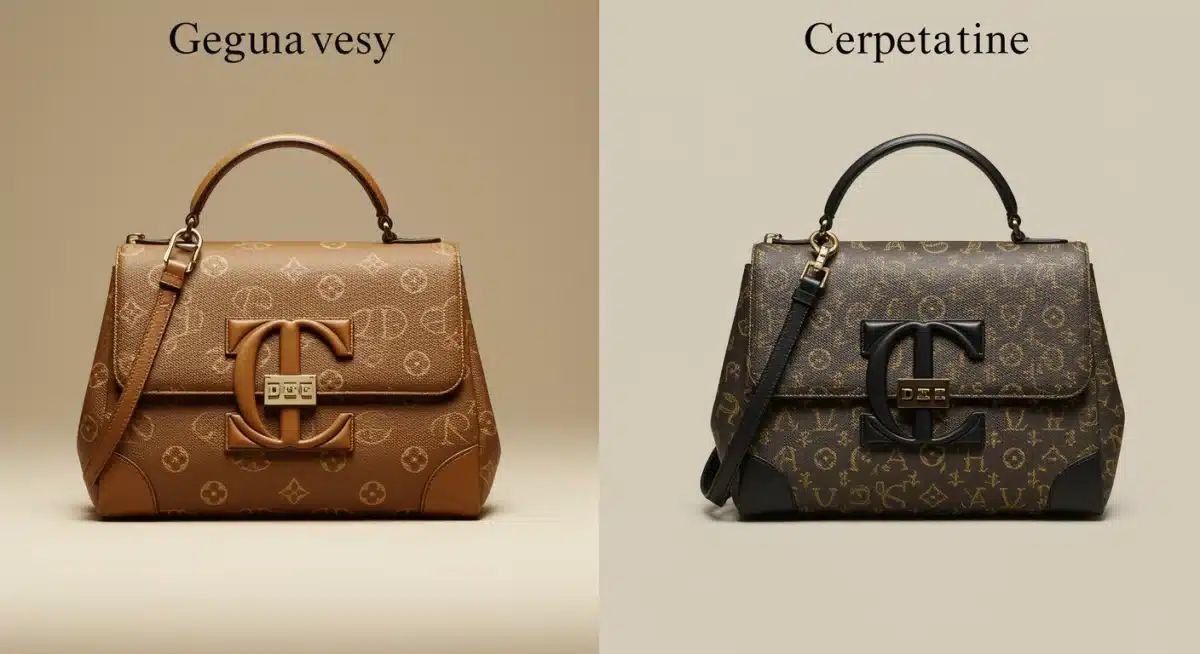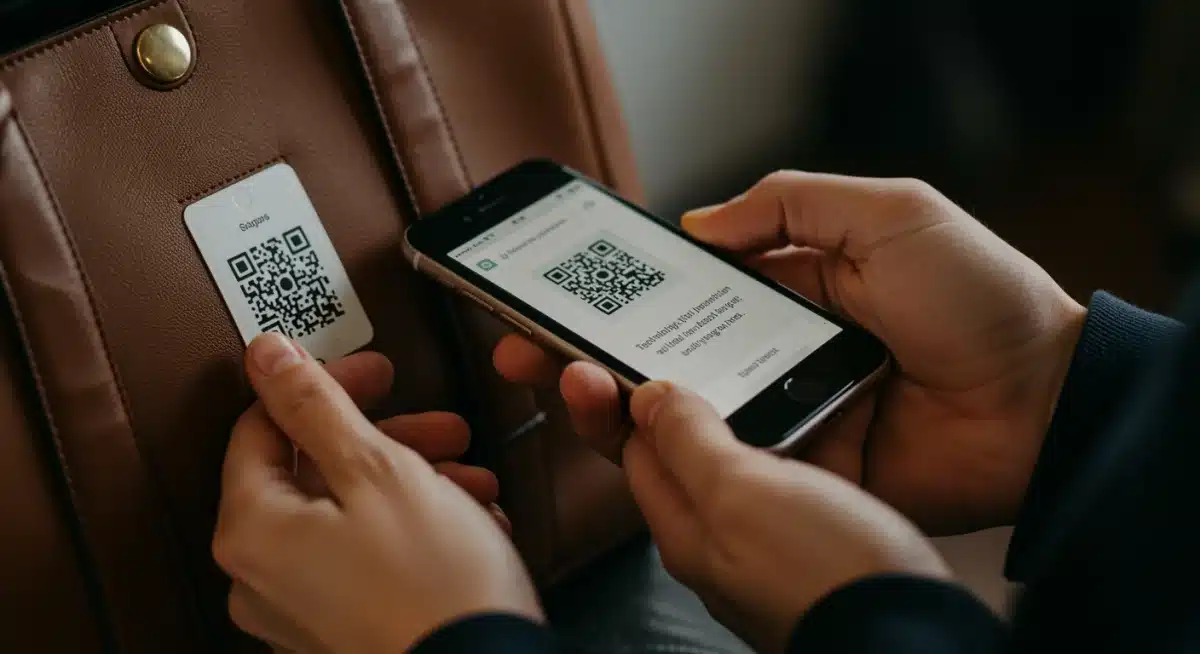Authenticating Designer Items: Avoid Scams with Expert Tips

Advertisement
To confidently authenticate designer items and avoid scams, always meticulously examine craftsmanship, materials, serial numbers, and branding, while also consulting professional authentication services for high-value purchases.
Have you ever fallen in love with a designer piece, only to hesitate, wondering if it’s the real deal? In today’s market, learning how to authenticate designer items is not just a skill, it’s a necessity to protect your investment and ensure you’re not falling victim to sophisticated scams. This guide will equip you with insider tips to confidently distinguish genuine luxury from clever fakes.
Advertisement
The allure of luxury and the rise of counterfeits
Luxury items have always held a special place in fashion, symbolizing status, quality, and timeless design. From iconic handbags to exquisite watches, these pieces are often seen as investments, passed down through generations. However, this allure also attracts a darker side: the rampant world of counterfeit goods. Understanding this landscape is the first step in learning how to protect yourself.
The global market for counterfeit goods is vast and ever-growing, fueled by demand for luxury items at a fraction of the price. These fakes range from obvious imitations to highly sophisticated replicas that can fool even a discerning eye. The rise of online marketplaces and social media has made it easier than ever for these counterfeit products to reach consumers, making the need to authenticate designer items more critical than ever before.
Advertisement
Why counterfeits are a problem beyond just price
While the immediate disappointment of buying a fake is financial, the implications extend much further. Counterfeit industries often fund unethical labor practices, organized crime, and can even pose health risks, especially with items like cosmetics or electronics. By understanding the true cost of counterfeits, consumers can make more informed decisions.
- Economic impact: Billions of dollars are lost annually by legitimate businesses.
- Ethical concerns: Counterfeit operations often involve child labor and unsafe working conditions.
- Quality and safety: Fake products rarely meet the safety and quality standards of genuine items.
- Brand devaluation: The proliferation of fakes can dilute a brand’s exclusivity and reputation.
The desire to own a piece of luxury is understandable, but being equipped with the knowledge to discern authenticity is paramount. This foundational understanding allows us to approach the authentication process with a clear perspective, focusing on the details that truly matter.
Mastering the art of visual inspection: materials and craftsmanship
When you’re looking to authenticate designer items, the first and most crucial step often involves a thorough visual and tactile inspection. Genuine luxury brands are renowned for their impeccable craftsmanship and the use of premium materials. Counterfeiters, while increasingly skilled, often cut corners in these areas, which can reveal the true nature of an item.
Start by feeling the material. Is it supple, smooth, or textured as it should be? Luxury leathers, for example, have a distinct scent and feel that cheaper alternatives cannot replicate. Pay close attention to the stitching – it should be even, consistent, and without loose threads. Many high-end brands use specific stitching patterns or thread counts that are difficult to perfectly imitate.
Examining hardware and logos
Hardware, such as zippers, buckles, and clasps, is another significant indicator. Authentic designer hardware is usually made from high-quality metals, feels substantial, and operates smoothly. Counterfeit hardware often feels lighter, cheaper, and may have visible imperfections or discoloration. Logos, whether embossed, engraved, or printed, should be crisp, perfectly aligned, and accurately spaced according to the brand’s specific guidelines.
- Zippers: Check the brand of the zipper pull (e.g., Lampo, Riri, YKK for some brands).
- Weight: Authentic hardware usually has a pleasant heft; fakes often feel light and flimsy.
- Finish: Look for consistent plating and a smooth finish without chips or scratches.
- Alignment: Logos on hardware should be perfectly centered and aligned.
The details in craftsmanship extend to every part of the item, from the lining to the edges. A genuine luxury piece will show meticulous attention to detail even in areas that are not immediately visible. Counterfeits frequently betray themselves through sloppy linings, poorly finished edges, or inconsistent patterns. This comprehensive visual scrutiny is a powerful tool in your authentication arsenal.
Decoding serial numbers and date codes: your item’s unique fingerprint
Beyond the outward appearance, many designer items carry internal identifiers that are vital for authentication. Serial numbers, date codes, and authenticity cards serve as a brand’s unique fingerprint for each product. Learning how to locate and interpret these can significantly aid your efforts to authenticate designer items and avoid falling for fakes.
Different brands employ different systems. For instance, Louis Vuitton uses date codes to indicate where and when an item was manufactured, rather than a unique serial number. Chanel, on the other hand, uses serial numbers that correspond to an authenticity card and a hologram sticker. Understanding the specific system for the brand you are examining is crucial. Research the brand’s current and historical coding practices, as these can evolve over time.
The importance of authenticity cards and packaging
While an authenticity card might seem like a straightforward indicator, it’s one of the easiest elements for counterfeiters to replicate. Therefore, an authenticity card should never be the sole basis for judgment. Instead, it should align perfectly with the item’s features and the brand’s specific card design, font, and material. Similarly, original packaging, such as dust bags and boxes, should be of high quality, with accurate branding and consistent design.
- Serial number placement: Know where the brand typically places its serial numbers or date codes.
- Font and spacing: Authentic codes will have specific fonts, sizes, and spacing that are consistent.
- Holograms/Stickers: Verify the security features on authenticity stickers; fakes rarely get these right.
- Card quality: Genuine authenticity cards are usually made from thick, high-quality cardstock with precise printing.

Remember that even with all these details, a sophisticated counterfeit might still present a challenge. Cross-referencing the serial number or date code with online databases or professional authenticators can add an extra layer of verification, especially for high-value items. This diligent approach helps confirm that the item’s internal identity matches its external presentation.
Researching brand-specific nuances: every detail counts
Each designer brand has its own unique set of characteristics, design philosophies, and manufacturing processes. To truly excel at learning how to authenticate designer items, you must delve into these brand-specific nuances. What might be a sign of authenticity for one brand could be a red flag for another. Generic authentication guides can only take you so far; detailed brand knowledge is where true expertise lies.
Start by familiarizing yourself with the brand’s history, its iconic designs, and common variations. For example, Louis Vuitton’s monogram canvas patterns are designed to be symmetrical and continuous, even across seams. Gucci’s GG pattern also has specific alignment rules. Knowing these intricate details helps you spot inconsistencies that counterfeiters often miss.
Understanding brand evolution and common counterfeit targets
Luxury brands evolve their designs, materials, and security features over time. A vintage item might have different characteristics than a contemporary one. Researching the specific model and year of manufacture can provide crucial context. Additionally, some brands and specific models are more frequently targeted by counterfeiters due to their popularity. Being aware of these high-risk items can make you extra vigilant.
- Signature details: Learn about unique hardware, stitching, or lining characteristics for each brand.
- Material variations: Understand the types of leather, canvas, or fabric a brand typically uses for specific lines.
- Logo variations: Research how logos have changed over time, including font, size, and placement.
- Packaging details: Note the specifics of dust bags, boxes, and care cards for different eras and collections.
The internet is an invaluable resource for this research. Official brand websites, reputable luxury forums, and dedicated authentication blogs can provide a wealth of information. Compare the item you are examining with numerous authentic examples from reliable sources. The more authentic items you observe, the better your eye will become at detecting subtle discrepancies that point to a fake.
The role of professional authentication services
While developing your own authentication skills is empowering, there are times when the expertise of a professional authentication service is invaluable. For high-value purchases, rare vintage pieces, or when you simply need absolute certainty, engaging a third-party expert is often the smartest move. These services specialize in verifying the authenticity of luxury goods and can provide a definitive judgment.
Professional authenticators have access to extensive databases of brand specifications, historical data, and often use advanced techniques, such as microscopic analysis or chemical testing of materials, that are not available to the average consumer. They can spot minute details that even the most dedicated amateur might overlook, making their services a critical step for serious collectors and buyers.
Choosing a reputable authentication service
Not all authentication services are created equal. It’s essential to choose a reputable and experienced provider. Look for services with a strong track record, positive reviews, and a clear methodology. Some services specialize in specific brands or types of items, so ensure they have expertise in the product you need authenticated. Many offer both online and in-person authentication options, providing flexibility.
- Reputation: Research reviews and testimonials from other luxury buyers.
- Expertise: Ensure they specialize in the specific brand or category of your item.
- Methodology: Understand their process, including tools and knowledge sources.
- Insurance/Guarantee: Some services offer an authenticity guarantee or insurance for their findings.
Investing in a professional authentication can save you from significant financial loss and emotional disappointment. It provides peace of mind, especially when purchasing from secondary markets or private sellers where recourse might be limited. Consider it an essential part of your strategy when you want to confidently authenticate designer items and protect your luxury investments.
Navigating online marketplaces and avoiding common scams
The digital age has revolutionized how we shop for luxury items, but it has also opened new avenues for scammers. Online marketplaces, while convenient, are hotbeds for counterfeit goods. Learning to navigate these platforms wisely and recognizing common scam tactics is crucial for anyone looking to authenticate designer items and make secure purchases.
Always exercise extreme caution when buying from unfamiliar sellers or platforms. Look for sellers with a long history of positive reviews and a clear return policy. Be wary of prices that seem too good to be true, as they almost always are. High-quality designer items command a certain price point, and deep discounts often signal a fake.
Red flags in online listings and seller behavior
Several red flags can indicate a counterfeit or a scam. Poor-quality product photos, generic stock images, or photos that don’t clearly show details are major warning signs. Vague descriptions, grammatical errors, or a lack of specific information about the item’s condition or origin should also raise suspicion. Communication with the seller is key; a legitimate seller will be transparent and willing to answer all your questions.
- Unrealistic pricing: Significantly lower prices than market value are a major red flag.
- Generic photos: Use of stock images or blurry photos instead of actual item pictures.
- Vague descriptions: Lack of specific details about the item’s condition, materials, or serial numbers.
- Pressure tactics: Sellers rushing you to buy or offering deals that expire quickly.
- Communication issues: Unwillingness to answer questions or provide additional photos/information.

Furthermore, be cautious of sellers who insist on off-platform payments or unusual payment methods. Always use secure payment gateways that offer buyer protection. If a deal feels off, trust your instincts. Taking the time to scrutinize listings and seller profiles can save you significant trouble and ensure you are genuinely able to authenticate designer items before committing to a purchase.
Protecting your investment: long-term strategies
Successfully authenticating a designer item is a victory, but the journey doesn’t end there. Protecting your investment in the long term involves careful handling, proper storage, and ongoing vigilance against potential damage or theft. Luxury items are meant to be enjoyed, but their value is best preserved with diligent care and smart practices.
Proper storage is paramount for maintaining the condition of your designer items. Store handbags in their original dust bags to protect them from dust and scratches. Stuff them with tissue paper or bubble wrap to help them retain their shape. Keep items away from direct sunlight, extreme temperatures, and humidity, which can damage materials like leather and fabric.
Maintaining and insuring your luxury collection
Regular maintenance, such as cleaning leather with appropriate products and polishing hardware, can extend the life and beauty of your items. For more intensive cleaning or repairs, always seek out specialized luxury repair services that understand how to handle delicate materials and intricate designs without compromising authenticity or quality. It’s also wise to document your collection with detailed photos and appraisals.
- Storage: Use original dust bags and boxes; stuff bags to maintain shape.
- Environment: Avoid direct sunlight, extreme temperatures, and humidity.
- Cleaning: Use brand-recommended products or professional cleaning services.
- Insurance: Consider insuring high-value items against loss, theft, or damage.
- Documentation: Keep receipts, authenticity cards, and appraisal documents.
Finally, for high-value collections, consider getting your items appraised and insured. This provides financial protection in case of unforeseen circumstances. By adopting these long-term strategies, you not only preserve the condition and value of your designer pieces but also solidify your confidence in knowing you own genuine articles, having successfully learned how to authenticate designer items and protect your assets.
| Key Authentication Factor | Brief Description |
|---|---|
| Craftsmanship & Materials | Examine stitching, leather quality, and overall construction for perfection. |
| Hardware & Logos | Check weight, finish, and precise alignment of all metal components and branding. |
| Serial/Date Codes | Verify internal identifiers against brand-specific formats and locations. |
| Professional Consultation | Utilize expert services for high-value items or when in doubt for definitive verification. |
Frequently Asked Questions About Designer Item Authentication
Common red flags include poor stitching, cheap-feeling materials, incorrect or blurry logos, flimsy hardware, and unusually low prices. Inconsistent fonts on tags or authenticity cards are also strong indicators of a fake.
Authenticity cards can be easily faked. While they are a part of the package, they should never be the sole basis for authentication. Always cross-reference the card’s details with the item itself and other known authentic features.
Serial numbers or date codes provide unique identifiers that indicate manufacturing details. Each brand has specific formats and locations for these codes. Verifying these against known brand patterns is a critical step in confirming authenticity.
It’s advisable to use a professional authentication service for high-value purchases, rare vintage items, or when you are uncertain about an item’s authenticity despite your own checks. Their expertise offers peace of mind.
Online marketplaces, especially those with private sellers, can have a higher risk of counterfeits. Always research the seller, look for detailed photos, and be wary of deals that seem too good to be true to avoid scams.
Conclusion
Navigating the world of luxury goods requires a keen eye and informed approach, especially when trying to authenticate designer items. By understanding the intricate details of craftsmanship, materials, hardware, and brand-specific identifiers, you empower yourself to make confident purchasing decisions. While personal vigilance is key, don’t hesitate to leverage the expertise of professional authentication services for added assurance. Protecting your investment means not only acquiring genuine pieces but also contributing to a more ethical market. With these insider tips, you are well-equipped to enjoy the enduring quality and prestige of authentic designer items, free from the worry of scams.





